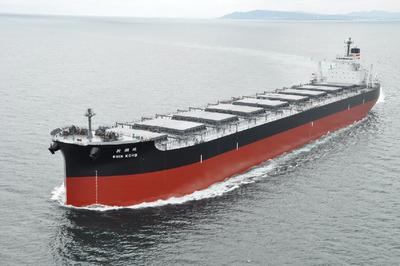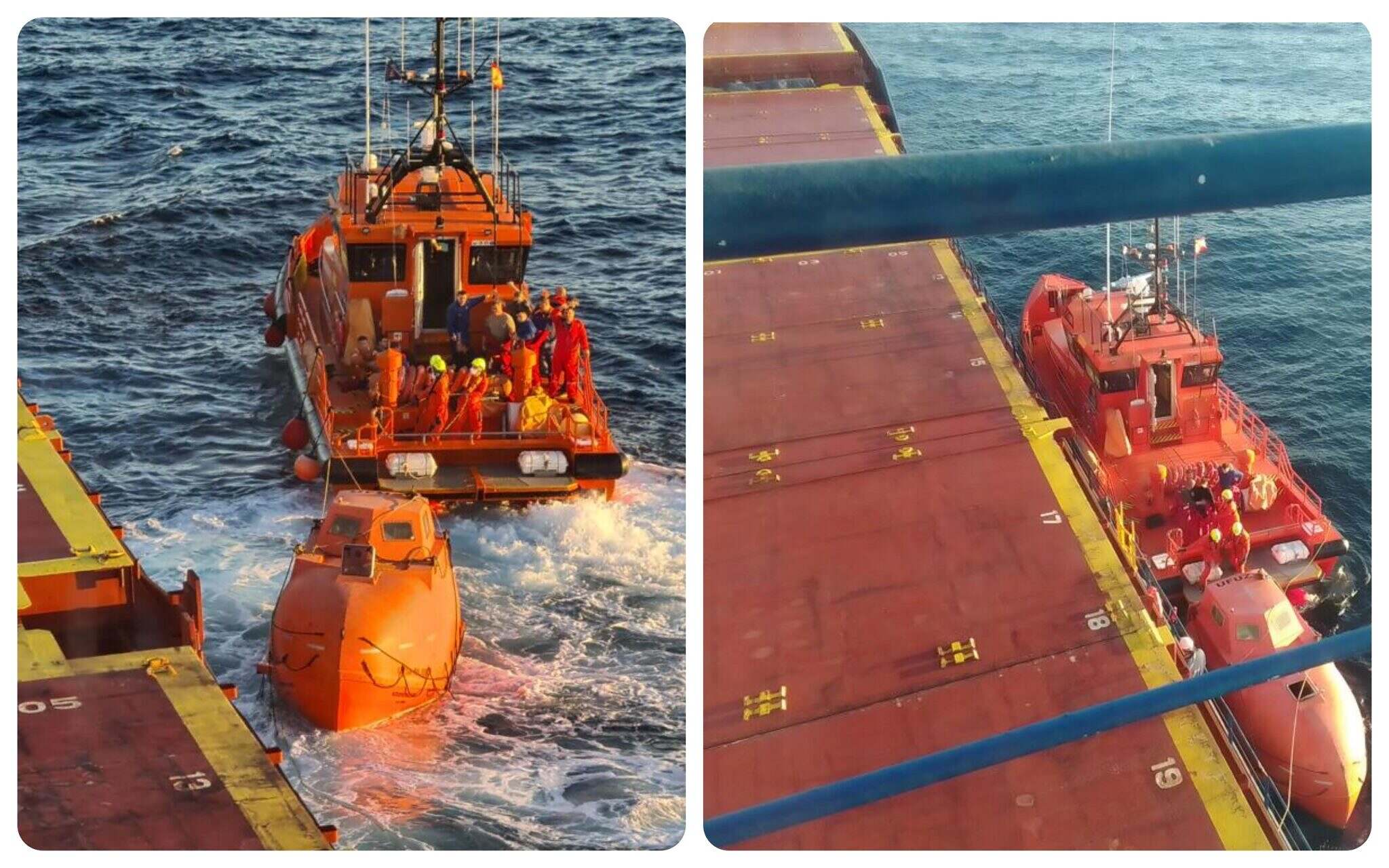The bulk carrier Shin Koho. File photo. Image courtesy NYK Lines
Overall confidence levels in the shipping industry recovered to their highest level in two years in the three months ending February 2013, according to the latest Shipping Confidence Survey from international accountant and shipping adviser Moore Stephens. There was improved expectation of freight rate increases over the next twelve months, particularly in the dry bulk sector, and greater likelihood of new investment in the industry.
In February 2013, the average confidence level expressed by respondents in the markets in which they operate was 5.8 on a scale of 1 (low) to 10 (high), compared to the figure of 5.6 recorded in the previous survey in November 2012. The survey was launched in May 2008 with a confidence rating of 6.8.
All categories of respondents expressed increased confidence over the three-month period. The confidence rating for managers of 6.2 (up from 6.0 last time) was the highest since August 2010, while that for charterers was up from 5.6 to 6.0, the highest since November 2010. Confidence on the part of owners was up from 5.5 to 5.7 (the highest since May 2011) while for brokers the increase was from 5.3 to 5.6, the highest level in the past twelve months. Geographically, although confidence was down in Asia (from 6.0 to 5.6) and in North America (from 6.6 to 6.1), it was up in Europe, from 5.3 to 5.8, its highest level since August 2010.
A number of respondents felt that there were positive signs that a recovery was on the way. One said, “Scrapping continues apace, and new orders have all but dried up. These are two of the main drivers for recovery, the third being demand, which will improve, with the result that we should see a measurable upturn by year-end.” Another noted, “Demand trends for seaborne trade are generally positive, and tonnage reaching obsolescence due to age and regulation will exit the market. Finance is competitive where available and, where it isn’t, owners and their ships will leave the market. Patience and strong cashflow management are essential.”
In the opinion of one respondent, “This year will be crucial in determining who will be able to benefit from the upswing in the market when it happens. It will depend on the banks’ attitude towards bad debt and increased foreclosure, the increased competitiveness of Japanese shipyards, and the phasing out of uneconomical, old ship designs.”
Some foresaw a continuation of difficult market conditions, such as the respondent who noted, “Last year was very difficult, and 2013 is likely to produce similarly meagre yields, so once again it will be all about trying to survive rather than moving forward.” In an even more pessimistic vein, another respondent maintained, “The shipping market has been getting worse every year since 2008, and there is unlikely to be any improvement in 2013. There are still crazy shipowners ordering new ships which will hit the water in two years’ time, so the world fleet will keep increasing at a faster rate than will cargo volumes.” Elsewhere it was noted, “Be careful when selecting your counter-parties, and be happy if you are able to cover your expenses in today’s market.”
A number of respondents were constrained to comment on the role of the banks, and the situation with regard to shipping finance generally. “The lack of available finance severely restricts many good deals from getting off the ground,” said one, while another pointed out, “There may be a measurable upturn in the shipping industry by end-2013, but will the banks be with us? I doubt it.”
Elsewhere it was noted, “Despite some areas for optimism in specialist niche markets, the cost of capital looks certain to increase. Moreover, there are ominous signs that the German banks will be forced to get to grips with their shipping loans, leading to an increase in enforcements and distressed sales, putting further pressure on asset prices.” Another respondent said, “It is beginning to look as if the banks are starting to foreclose, with KGs no longer defying gravity,” while another still warned, “Even if banks take action against owners who cannot meet their repayments, the ships will not disappear but will stay in the market and potentially cause problems for other owners who have been able to survive thus far.”
Fuel costs were uppermost in the thoughts of a number of respondents. While some talked about the exciting prospects for LNG propulsion, others remained concerned about the rising cost of operating with heavy fuel oil.
The likelihood of respondents making a major investment or significant development over the next twelve months was up from the previous survey, on a scale of 1 to 10, from 5.4 to 5.5 – the highest level since May 2011. Owners (up from 5.7 to 5.9, the highest level since May 2011) and managers (up from 5.5 to the highest level for two years at 5.7) were more confident than in our previous survey. And although charterers recorded a fall from 6.1 to 5.7 in this regard, the percentage of charterers who assessed the likelihood of their making an investment at 7.0 out of 10.0 or higher was up by two percentage points to 46 percent. The number of owners who thought likewise was up, also, from 44 percent to 47 percent.
One respondent noted, “Those who are able to purchase new designs of ships at competitive prices this year with delivery within the 2015 horizon should be well-positioned when the market turns. Newish ships based on old designs will very quickly become obsolete.”
Geographically, expectation levels of major investments were down in Asia, from 5.7 to 5.4, and in North America (from 5.4 to 4.9), but up in Europe from 5.2 to 5.5, their highest level since May 2011.
Demand trends, competition and finance costs once again featured as the top three factors cited by respondents overall as those likely to influence performance most significantly over the coming twelve months. The numbers were static for demand trends at 23 percent, up for competition (from 18 percent to 20 percent), and unchanged in the case of finance costs at 16 percent. Tonnage supply (up two percentage points to 13 percent) featured in fourth place, ahead of fuel costs, which were down one percentage point to 11 percent.
Demand trends remained the number one performance-affecting factor for owners, despite being down from 26 percent to 22 percent. Tonnage supply featured in second place at 18 percent (up from 17 percent last time), followed by finance costs, up one percentage point to 16 percent. For managers, meanwhile, competition, up from 16 percent to 20 percent, featured in first place, followed by demand trends (up two percentage points to 19 percent), and finance costs, down from 19 percent to 17 percent. For charterers, competition again was the leading performance-affecting factor, identified as such by 31 percent of respondents, up from 24 percent last time. Demand trends were in second place, up 7 percentage points to 29 percent, followed by fuel costs, up one percentage point to 18 percent.
Geographically, demand trends remained the most significant factor for respondents in Europe (unchanged at 24 percent), and North America (up 10 percentage points to 38 percent). In Europe, competition (up two percentage points to 19 percent) featured in second place, ahead of finance costs, down one percentage point to 17 percent. In Asia, meanwhile, competition (up from 19 percent to 21 percent) emerged as the number one performance-affecting factor, pushing demand trends (down two percentage points to 20 percent) into second place, ahead of fuel costs.
There was a 2 percentage-point fall (from 42 percent to 40 percent) in the number of respondents overall who expected finance costs to increase over the next twelve months. This is the lowest figure in the life of the survey to date. Charterers cannot seem to make up their minds in this respect. In August 2012, the number of charterers who thought that finance costs would increase rose by 18 percentage points to 52 percent. In November 2012 the figure was down by 20 percentage points to just 32 percent. Now, it has risen again, to 50 percent. The number of owners anticipating dearer finance this time was down by two percentage points to 37 percent (equalling the lowest figure in the life of the survey), while 41 percent of managers thought that finance costs were likely to rise over the coming year, down 10 percentage points on last time.
The number of respondents in Asia anticipating an increase in finance costs was down by 4 percentage points to 38 percent compared to last time, and the corresponding figures for Europe and North America were also down, from 43 percent to 39 percent, and from 43 percent to 42 percent respectively. In the Rest of the World, meanwhile, the numbers who thought that finance costs were going to rise was up by 8 percentage points to 46 percent.
Turning to freight rates, the numbers of respondents overall who expressed an increased expectation of higher rates over the next twelve months was up in the three main categories of tonnage covered by the survey. In the tanker sector, the numbers expecting higher rates rose by 4 percentage points to 35 percent. Charterers were the only category to show a fall (from 31 percent to 29 percent) in the number of respondents anticipating a rise in tanker rates compared to the previous survey. Owners recorded a two percentage-point increase to 36 percent, for managers the increase was from 27 percent to 32 percent, and for brokers from 33 percent to 42 percent. Geographically, the prospects for increased tanker rates were deemed lower this time by respondents in Asia (down from 35 percent to 33 percent), static in North America at 47 percent, and up in Europe from 28 percent to 36 percent.
In the dry bulk sector, meanwhile, there was a 19 percentage-point rise, to 50 percent, the highest figure in the life of the survey, in the overall numbers of those anticipating rate increases. Owners (up 20 percentage points to 50 percent), managers (up to 52 percent from 30 percent), and charterers (up 27 percentage points to 60 percent) were united in being more confident of dry bulk rate increases than they were in the previous survey. Even brokers (up 11 percentage points to 44 percent) were in agreement. Geographically, it was the same story. In Asia, expectations of higher dry bulk rates increased from 33 percent to 52 percent, in Europe from 30 percent to 51 percent, and in North America from 28 percent to 65 percent.
“We are very confident of bulk industry growth in the short term,” said one respondent, while another noted, “Bearing in mind the deliveries due very soon in most dry bulk sectors, and the stabilization of demand, we expect that the dry bulk market will soon show signs of recovery.” That view was echoed by the respondent who remarked, “We can expect higher freight levels in the second half of 2013, especially for handysize vessels.”
In the container ship market, meanwhile, there was a 7 percentage-point increase, to 34 percent, in the overall numbers expecting rates to go up. Indeed, expectation levels in relation to rate increases were up across all categories of respondent, most notably in the case of charterers (up 12 percentage points to 47 percent). Meanwhile, 36 percent of owners (compared to 27 percent last time) and 33 percent of managers (up 10 percentage points on last time) expected container ship rates to rise in the next twelve months. Geographically, expectations of improved rates were down in Asia (from 36 percent to 24 percent), but up in Europe (from 22 percent to 38 percent) and in North America, from 39 percent to 40 percent.
Moore Stephens shipping partner, Richard Greiner, says, “Another small increase in confidence is very good news. Indeed, two successive quarters of improved confidence is in many ways more encouraging than one sizable swing. It suggests that confidence is slowly building, indicating the start of a credible recovery.
“It is still early days, but the tone of the comments from respondents this time indicates something of a sea change. Whereas previous surveys have been dominated by concerns over specific issues such as tonnage overcapacity and the economic woes in Europe and elsewhere, this time there were no similar over-arching areas of concern identified by respondents. Indeed, the responses in many cases focused on planning for the future – for example by investing in new, fuel-efficient tonnage, exploiting new opportunities created by companies exiting the market, and exploring the possibilities for LNG as a clean fuel – rather than on compensating for past events.
“Improved confidence was reflected in another increase in the expectation levels involving potential new investments. Now is certainly a good time to invest, particularly for those who can identify a niche opportunity in a specific area, one for which there is growing demand and which is backed by a proper business plan.
“The indications are that the worst of the current shipping cycle could be over. But serious challenges lie ahead. Operating costs are going up, particularly fuel and manpower, and there is the added burden of increasing operational and environmental regulation. The cost of complying with the BWM convention has still not been accurately quantified, but it will not be insignificant. Indeed, one respondent likened it to a “ticking bomb which can go off at any moment, demanding enormous investment from already cash-strapped owners, and the banks will probably not be standing in line to support them.”
“Meanwhile, although freight rates still have a long way to go before they reach the levels seen at the height of the boom, the responses to the survey did reveal greater overall confidence in rate increases over the coming year in all three main tonnage categories. This was most evident in the dry bulk sector, where expectations of better rates were higher than at any time since the survey was launched in 2008. Although there is still a lot of new dry bulk tonnage coming into the market, scrapping levels in this sector have raced ahead, with well over 500 bulk carriers reported to have been consigned to demolition yards in 2012.
“Scrapping levels in all over-tonnaged sectors will need to be maintained, and improved upon, over the next twelve months, if shipping is to have a chance of returning to profitability. It is likely to be a slightly different industry which emerges from this prolonged downturn, one in which the banks will exert greater control for some time to come. Vessel values are likely to remain under pressure this year, and there is a lot of financial restructuring yet to be done. But shipping will retain its entrepreneurial flair, which is in no way undermined by operating from a stronger financial base.”
Unlock Exclusive Insights Today!
Join the gCaptain Club for curated content, insider opinions, and vibrant community discussions.

 Join The Club
Join The Club











